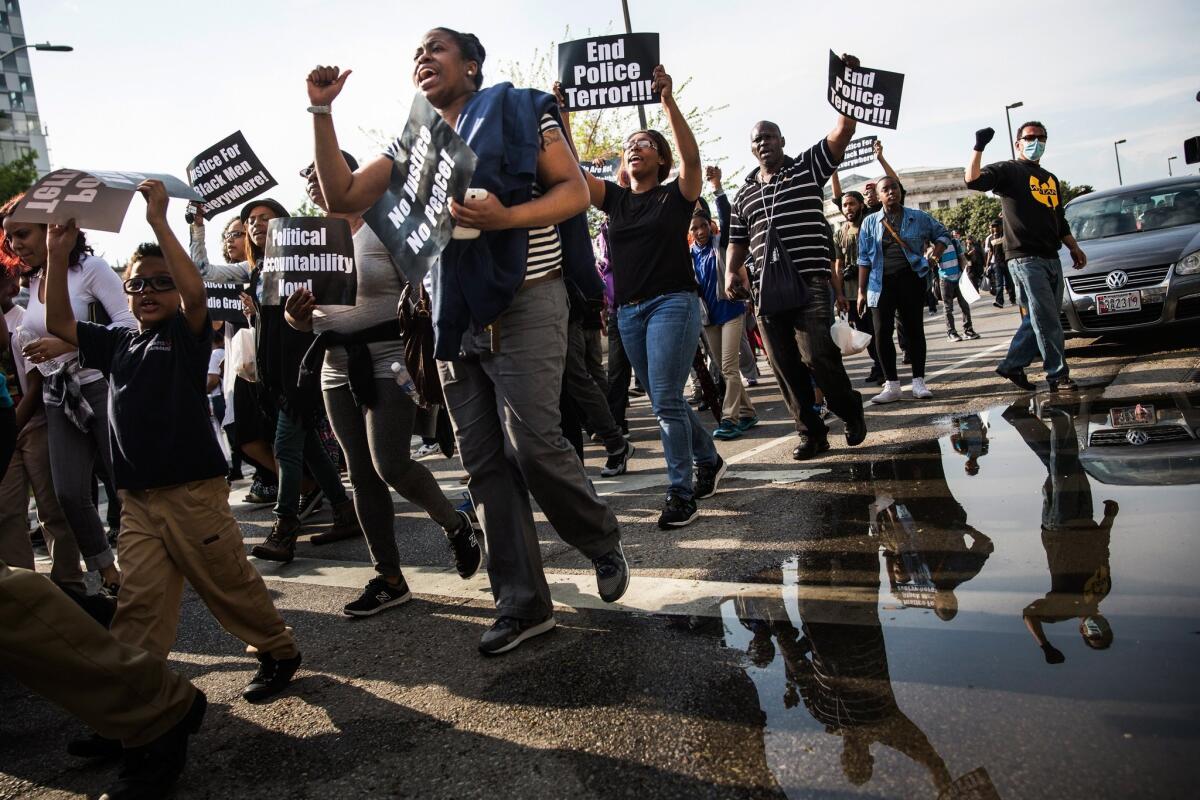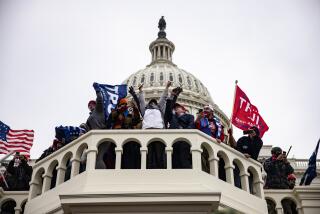Op-Ed: Today, a softer response to police violence than in 1960s and ‘70s

- Share via
For those of us who were around in the late 1960s and ‘70s, the headlines since the death of Michael Brown in Ferguson, Mo., in August have brought a dizzying sense of deja vu: The protests, the placards. The sobbing black families, the stone-faced white police chiefs. The endless debates in the press. The popularization of a new slogan, this time “Black Lives Matter.” We’ve been through it all before. Only this time, the public reaction has been largely, if not entirely, devoid of retaliatory attacks.
Violence today bubbles up in fits and starts, usually in the form of spontaneous riots — in Ferguson after the Brown killing, in Baltimore after Freddie Gray — while leaders encourage calm. Forty-five years ago, by contrast, militant groups like the Black Panthers called for supporters to kill cops, and a few murderous underground groups, most famously the Black Liberation Army, actually followed through, staging a series of assassinations that jolted the nation.
Why did some 1970s activists embrace organized, terroristic violence, and why have most of their successors rejected it?
To understand that, it helps to clear your mind of the Summer of Love and Martin Luther King Jr.’s calls for nonviolent resistance, because although it is King’s message that we recall most vividly, the civil rights era was always marked by darker voices, including those in the black community who called for armed “self-defense.”
At that time, police brutality was rampant — far worse than today, by most measures — and white policemen who killed black citizens were rarely prosecuted. Indeed, the events in Ferguson, followed by the deaths of Eric Garner in Staten Island and Walter Scott in South Carolina, echo a string of police killings decades ago, from Ronald Stokes, a Los Angeles member of the Nation of Islam in 1962, to Clifford Glover, a 10-year-old New York boy shot in 1973.
Among the first black leaders who called for retaliation was Robert Williams, an NAACP man in North Carolina who, after confrontations with the Ku Klux Klan, urged blacks to arm themselves in a 1962 book called “Negroes With Guns.” After fleeing to Cuba, Williams called for black servicemen to kill their white superiors during the Cuban missile crisis.
A far more prominent advocate was Malcolm X, who made police a focus of his demands for a bloody black revolution in American streets. After his assassination in 1965, Malcolm’s baton was picked up and carried forward by angry militants such as Stokely Carmichael and H. Rap Brown of the Student Nonviolent Coordinating Committee, who popularized the term “Black Power.”
But it was the Black Panther Party, formed in 1967 by a pair of Oakland college students, Huey Newton and Bobby Seale, who led a broad segment of black America into something approaching open conflict with urban police. The Panthers were initially a kind of neighborhood watch for Bay Area blacks; when they saw a white cop stop a black motorist, they would approach with guns drawn, demanding that the cop respect the black man’s civil rights. Time and again they angrily confronted police — first in Oakland, later around the country — in incidents that, when broadcast, introduced an entirely new paradigm to the strained relations between black Americans and police officers.
Panther rhetoric was stunningly inflammatory. It was the Panther newspaper that spread the term, “Off the Pig.” “The only good pig,” one New York Panther told startled white newspapermen, “is a dead pig.” At one point the Panther chief of staff, David Hilliard, announced that killing policemen wasn’t enough: “We will kill Richard Nixon,” he announced at a rally.
Perhaps unsurprisingly, attacks on urban policemen paralleled the rise in violent rhetoric. From 1964 to 1969, assaults on Los Angeles patrolmen quintupled. In Detroit they rose 70% in 1969 alone. Emboldened, a group of white militants calling themselves Weathermen went underground in 1970 and began plotting attacks on policemen in solidarity with the Panthers. Only after an accidental bomb explosion killed three of its members that spring did the group disavow murderous violence.
A Panther offshoot, the Black Liberation Army, or BLA, emerged in 1971, launching a series of attacks on police in New York, Atlanta and San Francisco; four were killed. The BLA remained a threat through 1972, when three of its members carried out perhaps the most gruesome assassination of police officers in New York history, shooting to pieces two officers, one of them black, on an East Village sidewalk. The group was finally eliminated after a series of attacks and shootouts in 1973, one of which resulted in the capture of its last leader, Joanne Chesimard, now known as Assata Shakur. After another group of militants freed her from a New Jersey prison in 1979, Shakur escaped to Cuba, where today she remains the highest-profile U.S. fugitive still under the protection of the Castro government.
Compared with what we experienced during the 1970s, even the Baltimore riots are tame. Kids are throwing rocks and looting, while most adults are telling them to go home.
No doubt part of this shift is attributable to the increased public-relations sophistication of U.S. police departments. After 40 years of dealing with incidents such as the Rodney King beating in 1992 and the shooting of Amadou Diallo in New York in 1999, many police administrators have learned to say all the right things, even if their officers don’t always do them.
The real change, though, is that most activists today no longer view violence as a productive means of protest. The Internet and cable news have made mass communication and organization easier. You don’t need to kill someone these days to get the country’s attention; you launch a Twitter campaign or call CNN.
Activists are perfectly aware that a segment of the American left turned to violence 45 years ago, and its efforts brought little but death and condemnation. After the shootings of two officers in Ferguson in March, local leaders roundly denounced any act of anti-police violence, lest it “hijack” their nonviolent movement. One, John Gaskin III, termed the attack “disgraceful and cowardly” and condemned violence as something “that gets us absolutely nowhere.” In Baltimore last week, Pastor Jamal Bryant, who delivered Gray’s eulogy, said rioting was disrespectful of the bereaved.
Of course it’s possible that activists will change their tune. Some have already. “We are all starting to believe that holding hands, following pastors and peaceful protests are pointless,” the Baltimore native D. Watkins wrote in the New York Times. “The only option is to rise up.” If this type of rhetoric spreads as it did during the 1970s, we know where it will lead. We’ve tumbled down that slippery slope before.
Bryan Burrough is a special correspondent at Vanity Fair and the author of “Days of Rage: America’s Radical Underground, the FBI and the Forgotten Age of Revolutionary Violence.”
Follow the Opinion section on Twitter @latimesopinion and Facebook
More to Read
A cure for the common opinion
Get thought-provoking perspectives with our weekly newsletter.
You may occasionally receive promotional content from the Los Angeles Times.









